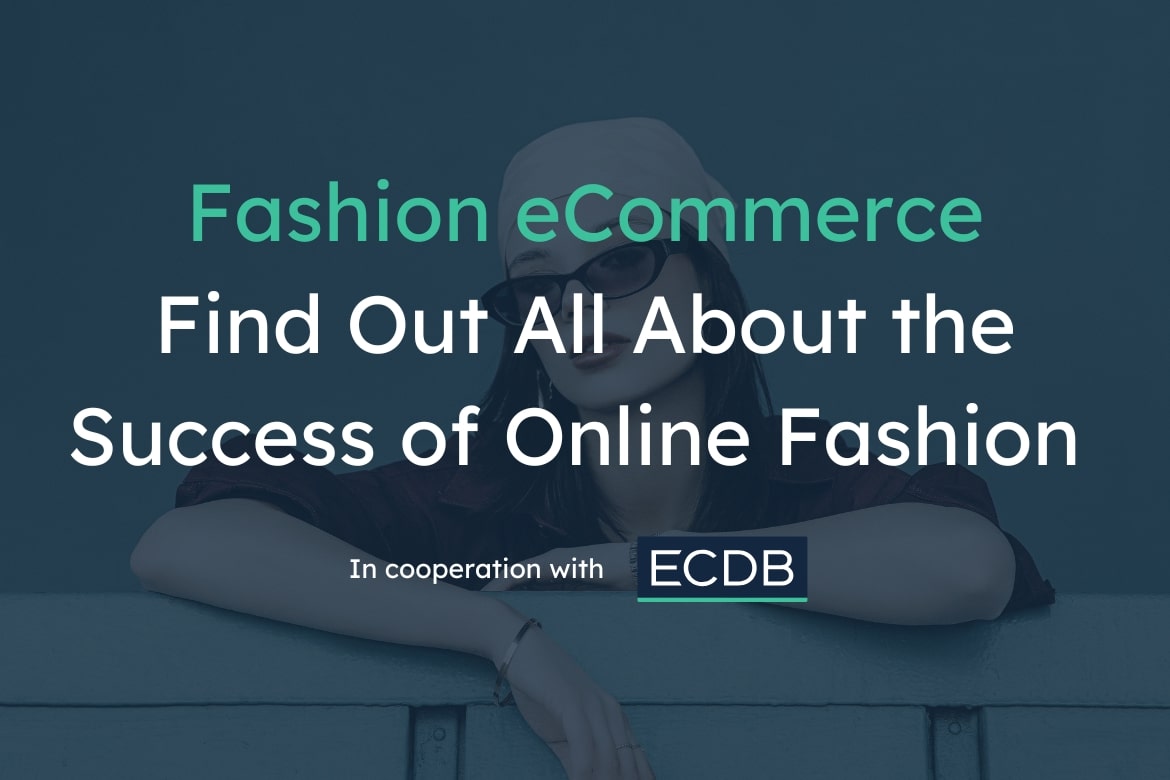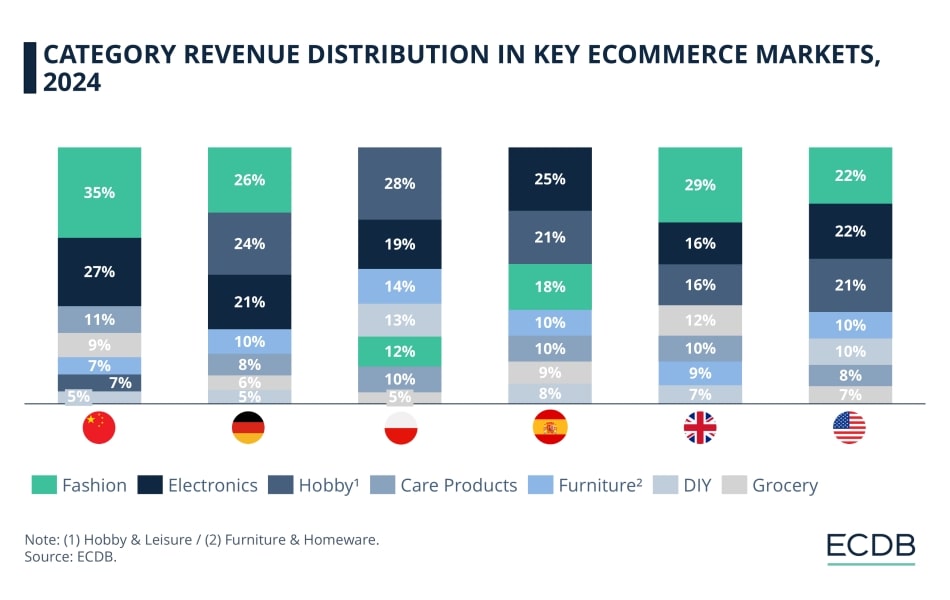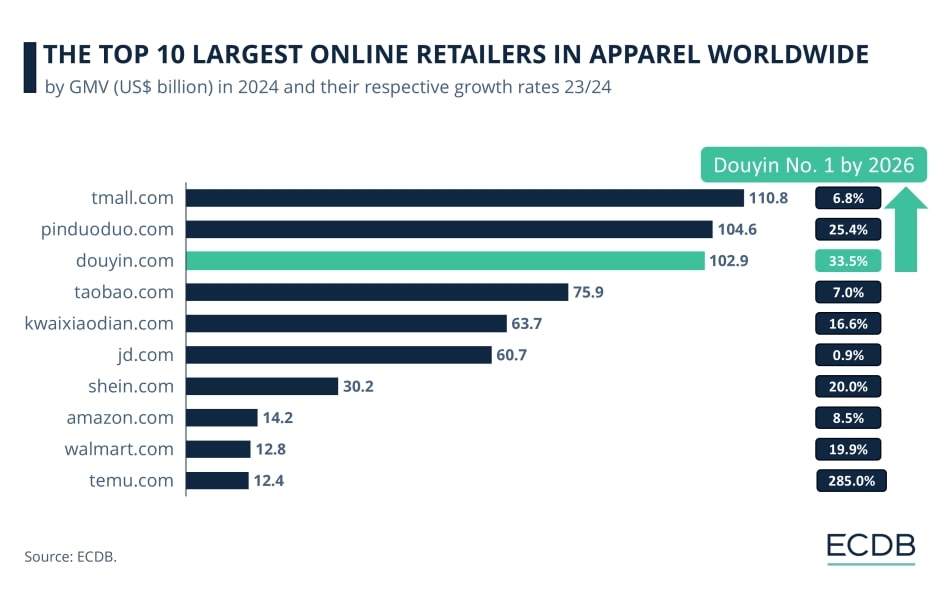Why fashion is the number one eCommerce category and which providers & concepts are on top
Written by
Editorial TeamPublished on
Fashion is one of the primary growth drivers of global eCommerce. And the market is experiencing deep shifts at the moment. Learn why fashion is the number one eCommerce category and which providers and concept are on top in this article featuring insights from ECDB. (Ad)

Commercial collaboration
By Nadine Koutsou-Wehling, Data Journalist
Fashion is one of the primary growth drivers of global eCommerce. And the market is experiencing deep shifts at the moment.
New business models meet established production ways, introducing a broader range of choices for consumers to make: Price is one of the deciding factors for purchases, but high-end segments remain relevant for styles and brand identity.
In recent years, new business models emerged. One of the most notable is reCommerce. Platforms like Depop, Vinted, or the RealReal and Poshmark belong to the thriving retailers for fashion right now.
Let’s have a look at fashion’s many faces.
Fashion is the largest product category by revenue in key markets
Fashion and eCommerce are the perfect fit. Fashion products include apparel, bags & accessories and footwear, and they are frequently in demand by consumers.
The suitability of fashion for online channels is reflected by its popularity in key online markets. In Greater China, Germany, the United Kingdom and United States, fashion is the number one eCommerce category, accounting for the largest share of market revenue.

Fashion is most important in China, where the category generates 35% of total market revenues. Second comes the United Kingdom with 29% and Germany is third with 26%.
But fashion is not the biggest category everywhere. In Spain, fashion is third-largest behind electronics and hobby & leisure. It does not even rank within the top 3 product categories in Poland, but accounts for a 12% share.
This shows that market dynamics, the provider landscape and consumer preferences play an important role in how product categories are distributed among markets. There is no one-size-fits-all solution. Despite this, common patterns do exist.
Reasons for fashion’s appeal in eCommerce
Fashion items are among the best-selling products in eCommerce. After all, everyone needs clothing, and the more frequent the style updates, the better.
Unlike furniture or TVs, fashion products are not bulky and do not break easily. This makes fashion items ideal for delivery, including global shipping.
Marketing fashion products has always been straightforward. But with newer marketing techniques such as influencer and micro-influencer marketing, consumers see products in action and need to take only few steps to imitate them.
Additionally, novel technologies like AR and VR facilitate the decision-making process and reduce returns. Formats like livestream shopping make buying fashion products (and other products) interactive and fun. This successful strategy pays off, as will be seen in the next section.
Largest online retailers for global apparel
Some platforms stand out from others in fashion. They have a fitting approach that allows world audiences to easily join in. One such platform is Douyin, the Chinese sister company of TikTok Shop, which is powered by ByteDance.

The top ten retailers in the global apparel eCommerce sector are mostly Chinese. Noting the previous part, fashion is the largest eCommerce category in Greater China. This trend is confirmed by the wide range of large providers with competitive prices.
In particular, Douyin is currently experiencing a notable surge. Already ranking third, close behind its competitor pinduoduo.com, douyin.com boasted a growth rate of 33.5% in 2024. If this trajectory continues, the platform will soon surpass tmall.com, which is growing at a slower rate of 6.8%.
What makes some providers stand out over others
The reasons for Douyin’s surge encompass the aforementioned factors: like TikTok, products on Douyin are easily marketed in a natural setting, which makes consumers eager to buy the items. Fashion is particularly well-suited to this approach, as it is a popular category and a frequent subject of styling trends.
Generalist and low-cost retailers follow further down the list, emphasizing the aspects of convenience and affordability when it comes to shopping for fashion.
What business concepts stand out?
There are several ways to distinguish fashion eCommerce offerings, three of which are listed below. They include ways to categorize the most prevalent stores and marketplaces in eCommerce.
Price-related: High-end vs Affordable
High-end retailers focus on luxury products, limited collections, and brand prestige. Examples include net-a-porter.com, farfetch.com, and ssense.com.
Affordable fashion platforms, on the other hand, appeal to cost-conscious shoppers through value pricing and mass-market appeal – such providers are H&M (hm.com), asos.com, and uniqlo.com.
Together, the affordable fashion platforms have a much wider reach and appeal than the high-end retailers who are more exclusive. In 2024, H&M, Asos and Uniqlo collectively generated an eCommerce GMV of US$13.8 billion, compared to US$3.8 billion by Net-a-Porter, Farfetch and SSENSE.
Production-wise: Traditional vs Fast-fashion vs Ultra-fast fashion
Traditional fashion brands operate with longer design cycles and seasonal collections, prioritizing craftsmanship and durability (e.g., Ralph Lauren and Levi’s).
Fast-fashion companies like zara.com and hm.com accelerate production to respond quickly to current trends.
The traditional and fast-fashion brands generated similar revenues in 2024. Among the aforementioned brands, Ralph Lauren and Levi’s generated US$13.4 billion in global eCommerce, while H&M and Zara were at US$13.9 billion.
Both are significantly behind the ultra-fast fashion platforms though, such as shein.com and temu.com. These novel upstarts take the fast-fashion concept a step further with rapid product turnover, real-time design feedback, and high output volumes. Both Temu and Shein generated over US$54 billion in 2024. However, it should be noted that Temu sells many other categories than fashion alone.
Platform-dependent: DTC, 1P vs 3P, subscription, secondhand (C2C)
Direct-to-consumer (DTC) brands sell directly from their own websites – examples include everlane.com and glossier.com.
First-party (1P) retail refers to platforms like Zalando or Amazon Fashion selling items they own, while third-party (3P) models host independent sellers. Subscription services like Stitch Fix and Rent the Runway offer personalized selections or rental options. Currently, there is a worldwide shift toward 3P marketplaces. The concept allows for a wider product variety at competitive pricing.
Secondhand, or consumer-to-consumer (C2C) platforms such as Depop, Vinted, Poshmark and Vestiaire Collective, enable users to resell and purchase pre-owned fashion items. These marketplaces are on a global surge right now, particularly Vinted, which is expanding at lightning speed in Europe.
Conclusion: The success of fashion in eCommerce depends on price, frequent style updates, and brand identity
Fashion is an evergreen of an eCommerce product category, appealing to consumers in all ways of life. As fashion is not rarely bought multiple times throughout a year, the types of its marketing are various and full of innovation and creativity.
While revenues in the fashion eCommerce industry, present and future, are guaranteed, the market is competitive and dynamic, subject to frequent shifts and hard to enter in a way that attracts and holds consumer interest. In addition, price wars push down margins, except for the brand-identity-driven providers who sell their products at a higher margin as a unique distinction.
***


